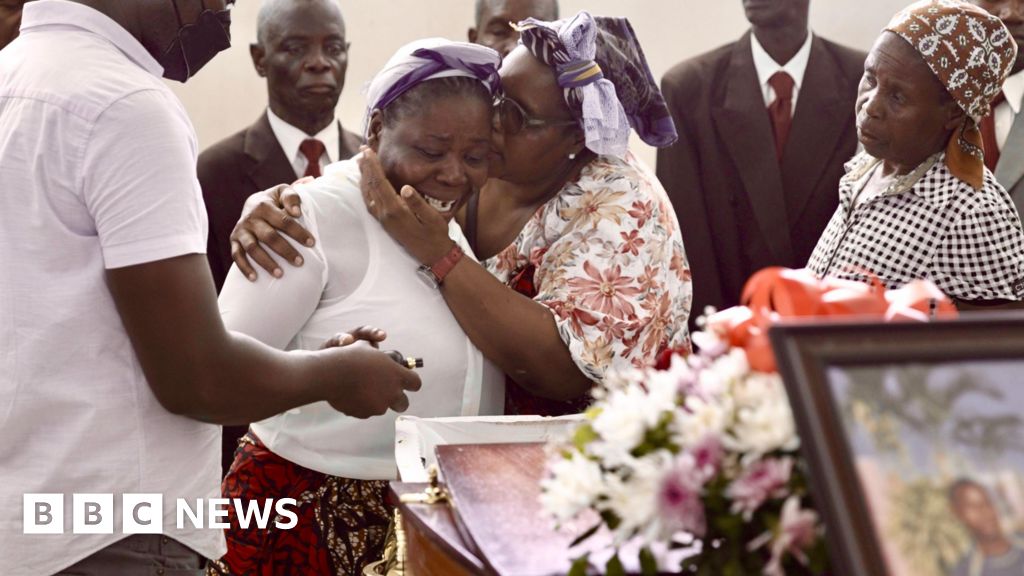With the United States presidential election just over three weeks away, the campaigns of Kamala Harris and Donald Trump are going into overdrive, with last-minute appeals to voters.
Need a quick breakdown of the week’s biggest political news? Look no further.
We’ll get you up to speed with five key takeaways from the past seven days and an overview of where the candidates stand in the polls.
 Former US President Donald Trump and current Vice President Kamala Harris are headed for a showdown on November 5 [Eduardo Munoz and Nathan Howard/Reuters]
Former US President Donald Trump and current Vice President Kamala Harris are headed for a showdown on November 5 [Eduardo Munoz and Nathan Howard/Reuters]The election at a glance
- How many days left?
There are 23 days left before the November 5 election.
- National polling averages show Harris with slight lead
As of October 11, the polling aggregator FiveThirtyEight shows Vice President Kamala Harris up by 2.5 points, with 48.5 percent support compared to former President Donald Trump’s 46 percent.
Another polling average, from the website 270toWin, shows Harris again with a marginal lead, with 49.3 percent support. Trump, meanwhile, is at 46.5 percent.
- Any surprises?
Harris, the Democrat, could be poised to flip one of Trump’s key demographics: suburban voters.
On October 10, the news agency Reuters and the market research poll Ipsos released a poll that showed Harris led her Republican rival 47 percent to 41 among suburbanites.
But two days later, The New York Times and Siena College released a poll that indicated Harris could be slipping among Black voters. She pulled in 78 percent support — a drop from the estimated 90 percent support her fellow Democrat, Joe Biden, earned in 2020.
 A car plies the floodwaters in a neighbourhood of South Daytona, Florida, on October 11, after the passage of Hurricane Milton [Ricardo Arduengo/Reuters]
A car plies the floodwaters in a neighbourhood of South Daytona, Florida, on October 11, after the passage of Hurricane Milton [Ricardo Arduengo/Reuters]Hurricane Milton becomes disinformation battleground
Within three days of forming in the Gulf of Mexico, Hurricane Milton had billowed into a powerful Category 5 storm, earning the highest ranking on the Saffir-Simpson scale.
Such rapid development had rarely been seen. The National Oceanic and Atmospheric Administration dubbed Milton “one of the most intense hurricanes on record in the Atlantic basin”.
And it was heading straight for Florida, the southernmost state in the contiguous United States.
But as Florida braced for impact, politicians were preparing not just for lashing wind and storm surges but also a flood of disinformation.
Swaths of the US South were still recovering from September’s Hurricane Helene, and in the weeks since, Trump had made a series of false claims, including that the Democrat-led federal government was “going out of their way to not help people in Republican areas”.
On the night Milton made landfall, outgoing President Joe Biden slapped back, using his White House remarks about the storm to blast Trump, his erstwhile political rival.
“Over the last few weeks, there’s been reckless and irresponsible and relentless promotion of disinformation and outright lies about what’s going on,” Biden said, calling the distortions “un-American”.
“Former President Trump has led this onslaught of lies,” he added.
Harris herself blasted Trump in remarks in Las Vegas. “This is not a time for people to play politics,” she said, in reference to the Republican.
 Democratic presidential nominee Kamala Harris sits down with podcast host Alex Cooper [Call Her Daddy/Handout via Reuters]
Democratic presidential nominee Kamala Harris sits down with podcast host Alex Cooper [Call Her Daddy/Handout via Reuters]Trump and Harris spar with mainstream media
Once criticised for failing to appear on the national media circuit, Harris zipped from one interview to the next at the start of this week, as part of a recent media blitz.
It was a stark contrast to the start of her campaign. After she announced her candidacy on July 21, Harris failed to appear in any major interview until late August.
And even then, it was a joint interview with her running mate, Tim Walz. Her first solo interview came a couple of weeks later, on September 13, with a local TV station in Philadelphia, Pennsylvania.
But in the past week, Harris has cranked up the frequency of her media appearances. In the space of two days, she appeared on the podcast Call Her Daddy, on the radio with The Howard Stern Show and on television with talk-show appearances on The View and The Late Show with Stephen Colbert.
And her prerecorded interview with the vaunted TV newsmagazine 60 Minutes also aired on Monday.
That last interview was meant to be part of a pair: 60 Minutes had invited Donald Trump to sit down for a recording as well.
But host Scott Pelley announced that the Trump team had pulled out of the agreed-upon interview, citing “shifting explanations”, including that the Republican might be fact-checked on air.
The friction between Trump and 60 Minutes did not end there. When a teaser version of the Harris interview showed the vice president answering a question differently than she did in the longer version, Trump accused the newsmagazine of trying to “make her look better”.
He also called on the Federal Communications Commission to “TAKE AWAY THE CBS LICENSE”. The remarks earned a rebuke from the commission’s chair, who warned that such an action would threaten free speech.
 Democratic presidential nominee Kamala Harris looks on during a campaign event in Chandler, Arizona, on October 10 [Evelyn Hockstein/Reuters]
Democratic presidential nominee Kamala Harris looks on during a campaign event in Chandler, Arizona, on October 10 [Evelyn Hockstein/Reuters]Harris touts health as advantage over Trump
Through much of the 2024 election, questions of health and competency have loomed large — even dooming one candidate’s run.
After a dismal debate performance in June, the 81-year-old Biden was forced out of the presidential race amid questions about his age and ability to lead. It was the culmination of months of speculation and attacks, as Trump dug into Biden as a “weak” and “sleepy” old man.
But at 78 years old, Trump himself has faced questions about his age and mental competency.
Those questions came back into the spotlight this week. Last Sunday, The New York Times ran a story analysing Trump’s “rambling” and increasingly longwinded speeches, questioning whether his speech patterns reflected the toll of age.
And then, on Saturday, the White House released a memo touting his Democratic rival’s health.
The 59-year-old Harris, it read, “possesses the physical and mental resiliency required to successfully execute the duties of the Presidency”.
Trump has long touted his performance on cognitive tests as evidence of his abilities. On Saturday, his campaign spokesperson Steven Cheung responded to the media scrutiny with a statement, arguing that Harris “does not have the stamina” of Trump.
“All have concluded he is in perfect and excellent health to be Commander in Chief,” Cheung wrote of Trump.
 Former President Donald Trump holds a campaign rally in Reno, Nevada, on October 11 [Fred Greaves/Reuters]
Former President Donald Trump holds a campaign rally in Reno, Nevada, on October 11 [Fred Greaves/Reuters]Trump lays out blueprint for anti-immigrant agenda
On the campaign trail this week, Trump ratcheted up his attacks on migrants in the US, continuing a streak of false and incendiary claims.
Immigration has been one of the defining issues of Trump’s political career, and he has gone to great lengths to project a hardline image.
But critics warn his nativist rhetoric has grown increasingly extreme, echoing the sentiments of white supremacists and other controversial figures.
On Monday, Trump recorded an audio interview with the Hugh Hewitt Show, where he repeated false claims that murderers were crossing the border into the US en masse.
“Many of them murdered far more than one person, and they’re now happily living in the United States,” Trump said. “Now a murderer, I believe this: It’s in their genes. And we’ve got a lot of bad genes in our country right now.”
The Republican continued to play up the spectre of immigrants as criminals in appearances throughout the week, most notably on Friday.
Speaking in Aurora, Colorado, Trump pledged that, if re-elected, he would use his first days in office to “expedite the removal” of “savage gangs” from abroad, as well as invoke the Alien Enemies Act of 1798, a wartime law, as a tool for mass deportation.
He also called for the death penalty for migrants who killed US citizens.
Despite Trump’s portrayals of lawlessness, studies have shown that undocumented immigrants commit crimes at far lower rates than US-born citizens.
 A supporter cheers as Republican presidential nominee Donald Trump speaks during a rally in Coachella, California, on October 12 [Mike Blake/Reuters]
A supporter cheers as Republican presidential nominee Donald Trump speaks during a rally in Coachella, California, on October 12 [Mike Blake/Reuters]Bob Woodward’s book paints unflattering portrait
Reporter Bob Woodward holds near-mythic status in the US journalism sphere.
In 1972, he and his Washington Post colleague Carl Bernstein helped reveal President Richard Nixon’s role in the Watergate scandal, thereby precipitating the politician’s eventual resignation.
Since then, Woodward has published dozens of books, purporting to show the inner machinations of US politics. His latest, landing right in the midst of the heated presidential race, offered an unflattering glimpse of Trump’s alleged relationship with Russian President Vladimir Putin.
Entitled War, the book was released to news outlets on Tuesday in advance of landing on bookstore shelves.
In its pages, an unnamed aide alleged Trump called Putin at least seven times since leaving office. The book also claimed that, at the height of the COVID-19 pandemic, Trump sent virus-testing machines that were in short supply to Putin.
News outlets have since struggled to independently verify some of the book’s most headline-grabbing claims. And Trump’s team refuted them entirely, calling Woodward an “angry, little man”.
“None of these made up stories by Bob Woodward are true and are the work of a truly demented and deranged man,” Cheung, Trump’s spokesperson, wrote in a statement.
But the book does contain some high-profile named sources, including the former head of the Joint Chiefs of Staff, Mark Milley — once the highest-ranking military officer in the US.
He tells Woodward in the book that Trump is “fascist to the core”.

 1 month ago
11
1 month ago
11










 English (US) ·
English (US) ·